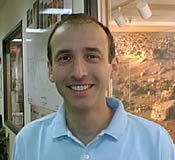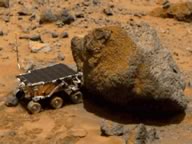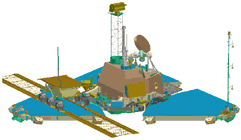Meet the Scientist: Dr. Matthew Golombek
Geologist, Mars Pathfinder Project Scientist
by Vesna Nikolic


Dr. Matthew Golombek
(click for larger image)
 |
|
Q: What are your main research interests?
A: Iím a planetary geologist, and basically, Iíve been mostly
interested in Mars geology. Right now, the research Iím
doing involves interpretation of data from the Mars Global
Surveyor, and Mars Pathfinder mission. Specifically Iím
working on structural features that are seen in the MGS
data, and Iím interested in surface characteristics and rock
distribution as seen in the MP data.
Q: How did you choose your field of interest?
A: I started as structural geologist, and I started looking at
structures on Mars. That sort of developed for a while.
Then with a chance to work on the mission, I started really
thinking about how surfaces vary on the Red Planet and
how you can predict what that surface would be like based
on remotely sensed data. Thatís of particular interest when
youíre selecting a landing site for a spacecraft, because
you want to make sure to the best of your ability that the
surface that youíre going to
land on is acceptable for your
lander and itís capabilities. I
spent a tremendous amount
of effort on Pathfinder
worrying about the landing
site, and Iíll be working on
the future landing sites for the
upcoming Mars mission,
using the same sorts of
techniques.


The Sojourner rover examining a rock
(click for larger image)
 |
|
Q: How do you choose a landing site?
A: A lot of it is determined by the engineering
capabilities of the spacecraft. For example, for Pathfinder,
it arrives at the outermost atmosphere of Mars, and it goes
through a complicated phase of using an aeroshell to lower
itself down, then a parachute comes out, and basically, you
need a certain amount of time and the density of an
atmosphere to slow the spacecraft to the correct terminal
velocity. So, elevation is very important, because you need
enough atmosphere to slow your vehicle down to the speed
that it needs to be going at. So, you canít land above the
certain elevation. In addition, most spacecraft are solar-powered,
and so you want as much power as you can
possibly get, and so you wind up landing near what we
call "sub-solar latitude" on Mars, which is basically near
equatorial within 25 degrees or so. And then, you go
through all the other things. If the spacecraft is susceptible
to landing on a rock, and hurting its underside, if it has
legs like Viking, or the airbags on Pathfinder qualify to a
rock of a certain height, then you worry about the total
number of rocks, and their distribution and their height.
And thatís a trick, since you
donít have a lot of information
about that. Then you worry
about dust. Too much dust is
probably not a good thing. It
might foul up the solar panels;
your rover might sink into it
for example. And you may
want rocks for analysis and so
on. Then you worry about
science that itíll do and thatís
terror to what instruments
you have on board the
spacecraft. So, itís a very
involved task.
Q: You were the Mars Pathfinder project scientist. How
was the job assigned to you?
A: Basically, with each project thereís a project manager
selected, and a project scientist selected. Those are the first
two people, and they are the two people that lead the
mission and the project effectively. Basically, the project
manager is typically an engineer who has overall
responsibility for the fabrication of the spacecraft, keeping
it on schedule. And a project scientist to make sure that
the science basically stays on the mission during that
building process. In a sense, itís two different groups of
people - thereís a whole group of engineers that know how
to build things, but really donít know much about Mars or
what you want to measure there, and a whole group of
scientists that probably couldnít build anything even if they
had to, and donít really know how, but theyíre really
interested in learning something about Mars. And obviously
there has to be a marriage of those two. Basically the project
scientist and the project manager work together to make
sure that happens properly. Now, in a more detailed sense,
the engineers for example need to know the environment
that they will be landing
in - what are the
temperatures, what are
the pressures, how
much atmosphere is
there, where can you
land, what are the
surface characteristics.
Those all go in the
design criteria for a
spacecraft and basically
the best people to
answer those questions
are scientists that know
about the planet.
Alternatively, as I said,
engineers are the best for building things and clearly, the
scientists need to work with them to make sure the
instruments can function properly on the spacecraft. So
basically, those two people are appointed by JPL and NASA
to carry out that function.


Mars Pathfinder and the Sojourner Rover
(click for larger image)
 |
|
Q: What were some key discoveries by the Pathfinder
mission and why are those discoveries important to us?
A: Iíd say thereís about half a dozen key things that were
really critical that we learned with Pathfinder. To put them
in the broadest perspective, I think the Pathfinder is showing
us a planet - Mars - that may have been more Earth-like
early on in its history than it is now. Right now, Mars is a
cold, dry, dessicating place and we found quite a bit of
evidence to suggest that it may have been warmer and
wetter in the past. And those key discoveries involved
looking at the surface and interpreting the history of how
that surface developed. And we believe that surface was
deposited by catastrophic floods in the past and so the rocks
that we saw on the surface actually looked as if they were
water worn and deposited by running water in the very
distant past. We found very magnetic dust that suggested
that that magnetism occurred by deposition of the liquid
water. We measured the moment of inertia of the planet,
which gave us bounds on what the diameter or the radius
of the internal core of Mars is and if it had one. We really
had no direct measure of that prior to Pathfinder. And those
were the key things. We found that the atmosphere was
much more dynamic than we ever expected, with small
dust devils as well as clouds and variety of other things.
Q: Now that NASA has slowed down with Mars missions,
what do you think is the future of the Mars exploration?
A: We lost two missions in í98, and in a sense it has slowed
down - for example weíll have only one orbiter in í01.
Thereís a period going on now where thereís a re-evaluation
of what we ought to be doing next that fits within the budget
and that wonít
obviously fail as
the í98 missions
did. So maybe we
paused, maybe
thatís the right
word, to make sure
that weíre doing
the right thing in
the right order, and
Iím sure weíll be
pressing on. I think
the reason that
Mars is such a
compelling place to
study is that we
may be able to answer one of the most fundamental
questions that we as people would want to know, and that
is: are we alone in the universe, will life form anywhere
that has stable liquid water, which is the absolute key to
life, or is something else required? So, if we go to Mars
and we see that the early environment wasnít in fact warmer
and wetter and life did not develop there, well then weíll
have to pause and say "Well, gee, what was so hard about
it? Why didnít it?" On the other hand, if we go there and
find that it did develop and that the conditions didnít persist,
then we would know that life can form pretty much
anywhere, and so it allows you to study in a scientific matter
what I think is a compelling question that many, many
people would want to know, and I donít think weíll stop
doing that just because of a little set back here.
Q: Do you have any final words of wisdom for youth
interested in Mars?
A: Follow your heart. Everyone develops at different levels,
speeds, at different times in their life. I donít think I was a
particularly outstanding high school student. Thatís OK. If
youíre really interested and excited in planetary exploration,
you should go for it, but you should also be very aware of
what the limitations are of any career path that you decide
on. If thatís a thing that really makes you happy, then you
should do it, but you should make sure youíve learned as
much as you can about it, before you just leap into it.
|

